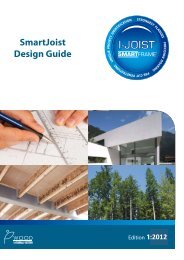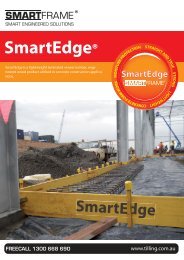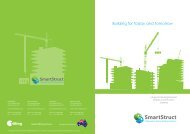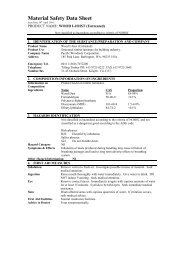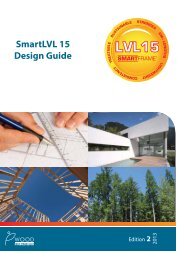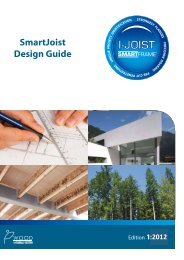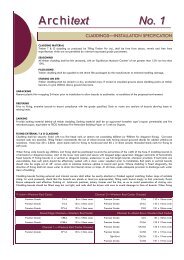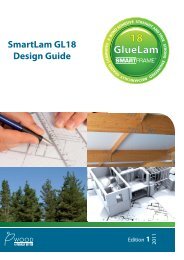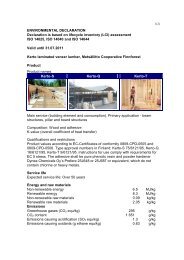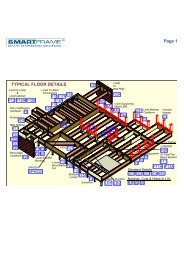SmartFrame Subfloor 2011.pdf - Tilling Timber
SmartFrame Subfloor 2011.pdf - Tilling Timber
SmartFrame Subfloor 2011.pdf - Tilling Timber
Create successful ePaper yourself
Turn your PDF publications into a flip-book with our unique Google optimized e-Paper software.
GENERAL INFORMATION - ABOUT FLOOR PERFORMANCE<br />
The “feeling” that is identified when a person walks on a floor<br />
is very subjective. Some people want to feel a very stiff floor<br />
and others want some ”give” so that it softens the footing.<br />
When people say the floor “bounces”, it may be vibrating.<br />
This sensation is often caused by lack of dead load such as<br />
furniture, direct applied ceilings or other materials to absorb<br />
or dampen the vibration.<br />
The allowable spans shown in the tables of this manual have<br />
been designed to meet the strength and serviceability<br />
criteria in AS1684.1 .<br />
FACTORS THAT CAN AFFECT FLOOR<br />
DYNAMIC PERFORMANCE.<br />
• The choice of flooring system<br />
• The depth, stiffness and mass of the joists<br />
• Spacing of joists<br />
• Fixing of sheathing to joists<br />
• Stiffness and mass of floor sheathing<br />
• Mass and stiffness of ceiling materials<br />
• Method of installation<br />
• Location and type of internal partitions and furniture<br />
FACTORS THAT CAN IMPROVE FLOOR<br />
DYNAMIC PERFORMANCE<br />
Glue-nailed floors will perform better than floors<br />
secured by nails alone.<br />
Deflection of the sheathing material between joists can<br />
be reduced by decreasing the joist spacing or using a<br />
thicker and/or stiffer sheathing.<br />
Proper installation is essential for dependable<br />
performance. Adequate and level support for the joists<br />
is necessary, as is correct fastening of the joists and<br />
sheathing.<br />
The installation of a ceiling to the bottom flange of the<br />
joists.<br />
Between joist blocking can provide some improvement<br />
to floor dynamic performance. It is emphasised that for<br />
between joist blocking to be effective, it is important<br />
that the blocking is continuous, this being easily<br />
achieved by the addition of a continuous bottom strap<br />
such as hoop iron strapping which is also attached to<br />
the end walls.<br />
If floor dynamic performance is a concern to either the<br />
client, designer or contractor, then the above variables can<br />
be altered to improve dynamic performance. Some stiff<br />
floors with very little dead load may tend to vibrate. This can<br />
generally be dampened by directly attaching the ceiling<br />
below the underside of the joists. Where there is no lining to<br />
the underside of the joists, it is recommended that between<br />
joist blocking be utilised to dampen this lightweight floor.<br />
If between joist blocking is to be used to improve floor<br />
dynamic performance, it is recommended that a blocking<br />
system (at least midspan, 1/3 points for large open rooms)<br />
similar to the one shown below should be adopted:<br />
BETWEEN JOIST BLOCKING FOR SmartJoists<br />
Floor sheeting glued AND nailed<br />
to joists and blocking<br />
SmartJoist between joist blocking,<br />
skew nailed with 2.8 x 60 mm nails.<br />
0.91 x 25 mm galvanised mild steel strap<br />
fastened to joists, blocking panels and END<br />
WALLS with 40 x 2.5 mm galvanised nails.<br />
SmartJoist<br />
floor joists<br />
DEEP JOIST BLOCKING OF SmartLVL<br />
AND TEMPORARY SUPPORT TO PREVENT<br />
JOIST ROLLOVER DURING<br />
CONSTRUCTION<br />
D<br />
W<br />
End trimmer to<br />
all cantilever<br />
joists<br />
Temporary restraint<br />
to link top edge of<br />
joists during<br />
construction<br />
W<br />
Temporary restraint to<br />
link top edge of joists<br />
during construction<br />
D<br />
3.6 metre maximum spacing of blocking<br />
pairs with temporary top edge restraint<br />
Additional temporary restraint<br />
to link top edge of joists and<br />
blocking pairs at a maximum<br />
of 3.6 m centres during<br />
construction for joists<br />
with D/B > 6<br />
<strong>SmartFrame</strong> Sub-floor Design Guide 3



